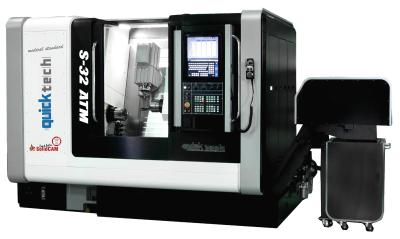
The compact, high-precision Quicktech S-32 ATM 9-axis twin-spindle mill-turn center combines integral-motor main- and sub-spindles with a 190° B-axis milling head and a fast automatic toolchanger to maximize output of small, complex parts. The machines are distributed in North America exclusively by Absolute Machine Tools Inc.
Steve Ortner, president and owner of Absolute Machine Tools, said, “These compact, versatile machines enable manufacturers to produce precise, complex smaller parts quickly, with the added benefits of the accuracy and consistency that result from processing the parts on a single machine tool. This machine is ideal for medical applications, for example.”
The S-32 ATM has 9 axes in total, including two turning spindles and a 190° B-axis milling spindle, serviced by a 24-tool (36 tool optional) arm-type automatic changer. Six fixed gang-type ID turning tools at subspindle result in a total capacity of 30 tools (42 optional). The machine’s compact 3,750mm (150") x 2,175mm (87") x 2,025mm (81") dimensions (including chip conveyor) promote efficient use of manufacturing floor space.
Both the main spindle and sub-spindle feature 6,000 rpm, 5-hp high-torque integral motors and have 42mm collet chucks (or 5" 3-jaw hydraulic chucks) with capacity for 30mm bar stock. The spindles feature a continuous C-axis with a braking system and are fully synchronized for fast and accurate part transfer.
The 12,000 rpm, 3-hp, HSK40-T B-axis milling spindle services both turning main and sub spindles and has a working range of 190˚ (+/-95˚ from vertical). The B-axis is locked in position by coupling for rigid turning operations. The 24-tool arm-type toolchanger, with an HSK-40T quick-change tooling system, produces tool change times of only 3 seconds. The subspindle moves in the X-, Y- and Z-axes, and in the X-axis can move above and below the centerline to clear the B-axis and enable it to have full tilting capabilities. At the subspindle are six gang-type turning tools that allow simultaneous turning operations. Rigid tapping is standard.
The S-32 ATM is built for precision and durability. The main and sub spindles employ P4 high-precision bearings for stability and heavy cutting ability. The machine frame and all major components are heavy Meehanite cast iron. Large 35mm Hiwin roller-type linear guideways in all linear axes provide stability and permit heavier machining. Substantial 32mm ballscrews are double anchored, pre-tensioned and direct coupled to the machine’s servomotors.
The machine is equipped with a Mitsubishi M830S control with a 15” LCD, and all spindles and axes employ Mitsubishi AC servomotors and amplifiers. Also available is a FANUC OiT-F control with a 15" LCD and matching FANUC motors and drives. Standard machine features include a bar feeder interface, parts conveyor and catcher, chip conveyor, collet chucks and a 400-psi coolant pump.
Contact Details
Related Glossary Terms
- automatic toolchanger
automatic toolchanger
Mechanism typically included in a machining center that, on the appropriate command, removes one cutting tool from the spindle nose and replaces it with another. The changer restores the used tool to the magazine and selects and withdraws the next desired tool from the storage magazine. The changer is controlled by a set of prerecorded/predetermined instructions associated with the part(s) to be produced.
- collet
collet
Flexible-sided device that secures a tool or workpiece. Similar in function to a chuck, but can accommodate only a narrow size range. Typically provides greater gripping force and precision than a chuck. See chuck.
- coolant
coolant
Fluid that reduces temperature buildup at the tool/workpiece interface during machining. Normally takes the form of a liquid such as soluble or chemical mixtures (semisynthetic, synthetic) but can be pressurized air or other gas. Because of water’s ability to absorb great quantities of heat, it is widely used as a coolant and vehicle for various cutting compounds, with the water-to-compound ratio varying with the machining task. See cutting fluid; semisynthetic cutting fluid; soluble-oil cutting fluid; synthetic cutting fluid.
- gang cutting ( milling)
gang cutting ( milling)
Machining with several cutters mounted on a single arbor, generally for simultaneous cutting.
- inner diameter ( ID)
inner diameter ( ID)
Dimension that defines the inside diameter of a cavity or hole. See OD, outer diameter.
- milling
milling
Machining operation in which metal or other material is removed by applying power to a rotating cutter. In vertical milling, the cutting tool is mounted vertically on the spindle. In horizontal milling, the cutting tool is mounted horizontally, either directly on the spindle or on an arbor. Horizontal milling is further broken down into conventional milling, where the cutter rotates opposite the direction of feed, or “up” into the workpiece; and climb milling, where the cutter rotates in the direction of feed, or “down” into the workpiece. Milling operations include plane or surface milling, endmilling, facemilling, angle milling, form milling and profiling.
- tapping
tapping
Machining operation in which a tap, with teeth on its periphery, cuts internal threads in a predrilled hole having a smaller diameter than the tap diameter. Threads are formed by a combined rotary and axial-relative motion between tap and workpiece. See tap.
- toolchanger
toolchanger
Carriage or drum attached to a machining center that holds tools until needed; when a tool is needed, the toolchanger inserts the tool into the machine spindle. See automatic toolchanger.
- turning
turning
Workpiece is held in a chuck, mounted on a face plate or secured between centers and rotated while a cutting tool, normally a single-point tool, is fed into it along its periphery or across its end or face. Takes the form of straight turning (cutting along the periphery of the workpiece); taper turning (creating a taper); step turning (turning different-size diameters on the same work); chamfering (beveling an edge or shoulder); facing (cutting on an end); turning threads (usually external but can be internal); roughing (high-volume metal removal); and finishing (final light cuts). Performed on lathes, turning centers, chucking machines, automatic screw machines and similar machines.

